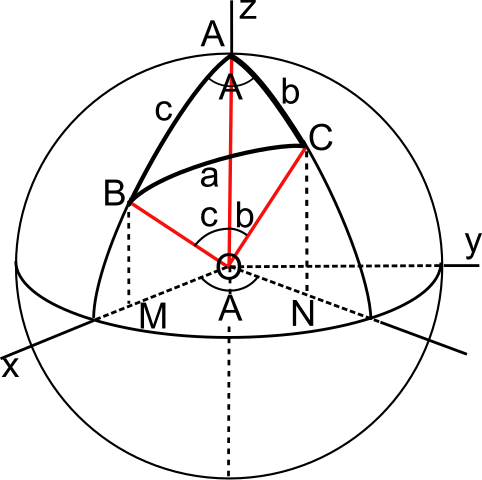
Caption: A diagram for explaining the identities of spherical trigonometry.
We will use this diagram in eplaining how to relate the angular diameter of a telescope field of view (FOV) subtended at the Earth. to the angular diameter the FOV subtends from the celestial equator at the about the same height above the celestial equator as the location of the FOV on the celestial sphere.
Explanation:
-
Note the
angular diameter
of a telescope
FOV
subtended at the Earth is
also just called the
FOV in a second meaning of the
term FOV.
- Some correspondances to the diagram:
the celestial sphere is the
sphere,
the celestial axis is the z axis.
the celestial equator is
the equator of the sphere.
Let R be the radius of the sphere.
- We use radians for our angular units rather than
degrees.
- We take angle c = d and call them both θ.
The declination &delta = &pi/2 - &theta is the
location of an azimuthal curve curve crossing the
FOV on the
celestial sphere.
The azimuthal curve has to be imagined.
We call the the length of this curve inside the FOV be &phi.
The angle &phi is the angular diameter the FOV subtends from the celestial equator at the about same height above the celestial equator as the location of the FOV on the celestial sphere.
- We let the FOV angle be α.
We imagine the FOV to be a cirle
on the diagram sphere
with its angular diameter endpoints being
B and C.
- We have two choices for the azimuthal curve: 1) its endpoints can be B and C, 2) it can pass through
the center of the FOV.
- Now for small α and &phi$, the arcs on these angles subtend on the
FOV are very nearly the same and we
will approximate them as being the same.
Our two choices for the azimuthal curve are reduced to one choice in this approximation.
We can now find an approximate relation between α and &phi$ that turns out to be 2nd-order good in small α and &phi$
Let the arc length be S. Now S = α*R and S = &phi*R*&sin(θ) = &phi*R*&cos(δ).
Solving for α gives &alpha = &phi*&sin(θ) = &phi*&cos(δ)
For almost all practical cases, this simple relation is all you need.
- However, we want to go further than the
the simple, plus ultra even.
Now we need spherical trigonometry which is the angle the
UNDER CONSTRUCTION
- A telescope
FOV (for a given
eyepiece) subtends a fixed
angular diameter
(which is also called FOV)
on the sky
(or celestial sphere) for the observer
on Earth.
- However, the angular diameter subtended
at the celestial axis point
at the vertical height of the
FOV increases with
with the magnitude of the height which means with
the magnitude of declination
of observation.
- Now the angular velocity
of the celestial sphere
(360 degrees per sidereal day
= sidereal hour)
is for rotation about the celestial axis---it does
NOT change with magnitude of declination.
- Since the
FOV
Credit/Permission:
© Peter Mercator (AKA User:Peter Mercator),
2013 /
CC BY-SA 3.0.
Image link: Wikimedia Commons:
File:Spherical trigonometry vectors.svg.
Local file: local link: field_of_view_declination_2.html.
File: Telescope file:
field_of_view_declination_2.html.